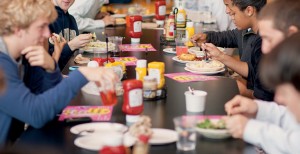
Helson Taveras, a sophomore at Columbia University, strides along West 116th, the heart of campus, passing students whose lives he has already helped to change. At an institution with a $9.6 billion endowment, students are hungry, and Swipes is a solution.
Last spring, Helson and his friend Julio Henriquez watched classmates turn to Facebook to connect with other students who had extra meals on their meal plans, asking for an opportunity — coordinating times and locations — to be “swiped” into a campus dining hall.
The two were well aware that financial aid packages often don’t cover meal plans. “Julio said to me, ‘We can make this exchange easier, faster, more efficient. This would make a perfect app,’” says Helson. That was July. They agreed to launch when students returned in September. That gave them six weeks.
Helson is a skilled programmer and was confident about tackling the back-end work. He knew, however, that the app would need a simple, cool user interface and landing page.
 For that he turned to Israel Moorer ’16, a Milton senior and a friend from Wolcott House. Spending the summer at home in Minneapolis, in the studio apartment he shared with his mother, Israel was very much in need of a project. Israel had no programming experience, but he connected with the mission.
For that he turned to Israel Moorer ’16, a Milton senior and a friend from Wolcott House. Spending the summer at home in Minneapolis, in the studio apartment he shared with his mother, Israel was very much in need of a project. Israel had no programming experience, but he connected with the mission.
“At home, I suffer from food insecurity,” says Israel. “Helson didn’t need to pitch me. Hunger is a personal issue for me, and someone had just given me the opportunity to do something about it. I didn’t look much further than that.”
Israel taught himself HTML in two days. He texted Helson for programming resources daily. Within a week, Israel was fluent in CSS. He learned two frameworks, in two different languages, in two weeks. Coding for up to eight hours a day, Israel was hooked, and focused.
In the meantime, Helson and Julio enlisted friends — designers and programmers — whose commitment was dependable. And Helson was at work on a project he describes as a “10,000 by 10,000 piece puzzle.” Besides the tight timeline, the app’s biggest challenge was a technical one: getting push notifications on your phone.
“We’re creating a peer-to-peer notification system,” says Helson. “When you request a swipe, you’re sending a notification to people on campus. If they can’t get the notification, the app is useless.”
For three weeks he struggled with a persistent error message. He learned a new language, spent days going through thousands of lines of code, repeatedly ran through the program execution. He was stuck.
“My parents saw me struggling, and my dad (who has no programming experience) asked me to walk him through it,” says Helson. “His response was, ‘It seems like something’s wrong with your configuration,’ which is the most basic, obvious, unhelpful thing he could have said.” Out of options, Helson followed his father’s advice and took a step back. He considered how he was setting up all the pieces. Lightning struck within 20 minutes. “That was very humbling,” Helson laughs.
Once the app functioned, the Swipes team needed messaging partners. After all, the program relies not only on students needing swipes, but also on those willing to give them. Fortuitously, the Columbia College Student Council (CCSC), in partnership with the student group First-Generation, Low-Income Partnership (FLIP), had named addressing food insecurity on campus as a priority. Those groups had the resources to spread the word about Swipes, campuswide.
 Because the app simply connects two individuals who have a Columbia.edu email address, the creators didn’t have to work their solution through the university’s administration or face any bureaucratic red tape.
Because the app simply connects two individuals who have a Columbia.edu email address, the creators didn’t have to work their solution through the university’s administration or face any bureaucratic red tape.
“Policy change will take years longer than any progress we can make using technology,” says Helson. “Students across the country tell us their schools are discussing solutions to food insecurity on campus, but that takes time. I think we’re at least two years ahead of seeing substantial administrative change.”
The number of students who contacted Helson and Julio, from Columbia and elsewhere, surprised them, as did the media coverage. In less than three months from launching, the success of Swipes was national news. Student journalists at Cornell and University of Virginia requested interviews, as did USA TODAY, Forbes magazine and Rolling Stone.
“With Swipes, we’re helping people feed other people, and that’s good news,” says Helson. “The media’s interest in sharing that good news feels incredible, personally and for Swipes. When we’re confident, on every level, with the way Swipes works, we can begin applying the program to other schools.” They’ve already moved on that goal. As of February, Barnard students are able to give and receive meals through the app.
“Through this process, I found out I like teaching people,” says Helson, who held a workshop for about 50 Columbia undergrads — an introduction to programming. “I’ve also learned there’s no way for me to remember what’s going on in my life at any given moment. Calendar management is CRITICAL.”
Through Almaworks — a startup accelerator at Columbia — Helson and Israel joined a dozen other startups from Columbia, UPenn, Harvard and Princeton, pitching in a daylong meeting to investors and venture capitalists. Beyond gaining experience presenting to a room like that and the chance to collaborate with those players, they earned honest feedback and good advice on how to grow the user base and consider next steps.
For his part, Israel has met “incredible people,” he says, “like Milton trustee Erick Tseng ’97 from Facebook, Paul Sagan and Paul English [co-founder of Kayak.com and Blade]. Moving from a conversation with VCs on a Saturday in New York to a history class at Milton on a Monday morning is challenging. Switching focus takes energy, and continually renewing my investment.”
Launching a startup with a tangible humanitarian outcome, Helson has become a full-stack developer — a title that wasn’t on his résumé at the start of the summer and is now. Facility with not only server work, but also website design and application functionality has earned him that credential.
The whole project has felt “weirdly empathic” for Israel. “I understand the thought process of a hungry person trying to use the app,” he says. “Every step, every click between a user and that meal is a deterrent. Understanding the urgency helps me as a front-end developer. Design-wise, we focus on simplicity. Food isn’t complicated. Our goal is connecting hungry students with food in the most efficient way possible.”
Swipes is quickly approaching 1,000 users — one-third signed up to give swipes. The app has helped exchange over 200 meal swipes.
The Swipes team is already focused on next steps. Version 2.0 might include a social feature, ratings option, and location check-in; it might include access to campus food events and not just dining halls. Perhaps it supports a campus-wide Emergency Meal Fund initiative. The team is also wrestling with long-term financial sustainability. Going nonprofit feels untenable, and becoming for-profit feels exploitative. Locating corporate meal sponsors might solve the problem.
“The idea of being a disruptor isn’t very appealing to me,” Helson says. “That word makes me picture walking into a room, throwing things, and tipping over tables. That’s not my goal. Ideally, we’re looking for a win-win, and we do believe that technology is the best way to get there.”
by Erin Berg



